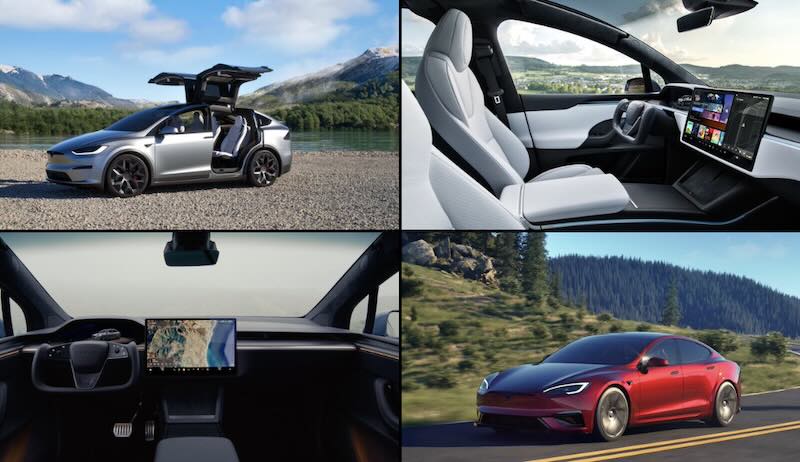Tesla has updated its Model S and X vehicles with incremental improvements and a $5,000 price increase across all configurations. While the changes address some functionality gaps, refresh raises questions about Tesla’s commitment to its premium segment as these models now represent less than 5% of company revenue.
The updates include front bumper cameras, enhanced lighting systems, and comfort improvements, but industry observers argue the changes don’t elevate the vehicles to match their premium positioning or justify the higher pricing.
Model S and X once generated nearly 100% of Tesla’s revenue in the company’s early years. Today, these flagship models contribute approximately $5 billion annually—less than 5% of total revenue and shrinking. Model Y alone generates ten times more revenue than the Model S and X combined.
This dramatic shift in revenue contribution has clearly influenced Tesla’s resource allocation decisions. Engineering teams now focus primarily on high-volume products and future technologies like the Cybercab and Optimus robot rather than premium vehicle refinements.
Tesla’s latest Model S and X updates represent a conservative approach that fails to address longstanding customer requests and competitive gaps.
The refresh doesn’t include steer-by-wire technology that would properly utilize the controversial yoke steering option. Omission seems particularly glaring given Tesla’s emphasis on innovation and the yoke’s divisive reception among owners.
Additionally, Tesla hasn’t addressed charging performance improvements that would enhance the premium ownership experience. Faster charging curves and improved battery management could differentiate these models from the company’s volume products.
Premium customers expect features like powered frunks, auto-opening doors for the Model S, and enhanced track performance for the Plaid variant. Additions would create clear separation between Tesla’s premium and volume offerings.
The company also missed opportunities to expand interior customization options or make Enhanced Autopilot standard on these high-priced vehicles.
Tesla faces competing priorities between maximizing current revenue and maintaining brand prestige through premium offerings.
From a pure revenue perspective, focusing engineering resources on high-volume products makes financial sense. Model Y’s success demonstrates where Tesla generates the most return on investment.
However, this approach risks diminishing Tesla’s premium brand positioning. Model S and X serve as technology showcases and aspirational products that influence customer perception across the entire lineup.
Tesla’s premium models should establish the company’s technological and luxury credentials. Current refresh doesn’t adequately differentiate these vehicles from competitors in the luxury EV segment.
Without meaningful upgrades, Model S and X sales will likely continue declining, potentially creating a negative feedback loop where lower volumes justify even less investment in future improvements.
Tesla’s current financial position suggests the company could invest more substantially in premium vehicle updates without significant financial risk. Tesla maintains strong cash reserves and could potentially afford more ambitious refresh programs.
The question becomes whether Tesla views the Model S and X as legacy products to be maintained with minimal investment or as important brand ambassadors worthy of continued development.
Tesla’s engineering teams now prioritize autonomous driving technology with Tesla Robotaxi (Cybercab), robotics (Optimus), and energy products over traditional automotive refinements. Shift reflects the company’s broader transformation from automaker to technology company.
However, maintaining premium vehicle excellence requires dedicated engineering attention that competes with these newer initiatives for resources and talent.
Premium vehicle buyers expect substantial improvements when manufacturers announce refreshes, particularly when accompanied by price increases.
Tesla’s updates feel incremental rather than transformative, potentially disappointing customers who hoped for more significant enhancements. Lighting improvements and minor comfort upgrades don’t address fundamental competitive gaps.
Luxury EV competitors continue advancing their offerings with features Tesla hasn’t matched in its premium segment. Gap could influence customer decisions as more alternatives become available.
Tesla’s premium models need to justify their pricing through superior technology, luxury features, and performance capabilities that aren’t available in volume products.
Tesla’s Model S and X refresh represents a missed opportunity to reinforce the company’s premium positioning. While business logic suggests focusing on high-volume products, these flagship models deserve investment that matches their aspirational role in Tesla’s lineup. The company’s approach to this refresh suggests it’s time to model better expectations for premium vehicle updates.
Related Post
Tesla has Launched All-new Model S Plaid Sport Seats
Tesla Actually Smart Summon Coming to Legacy Model S and Model X in Q4 in this year
Tesla Robotaxi Launches June 22nd in Austin: First Public Rides Without Safety Drivers
